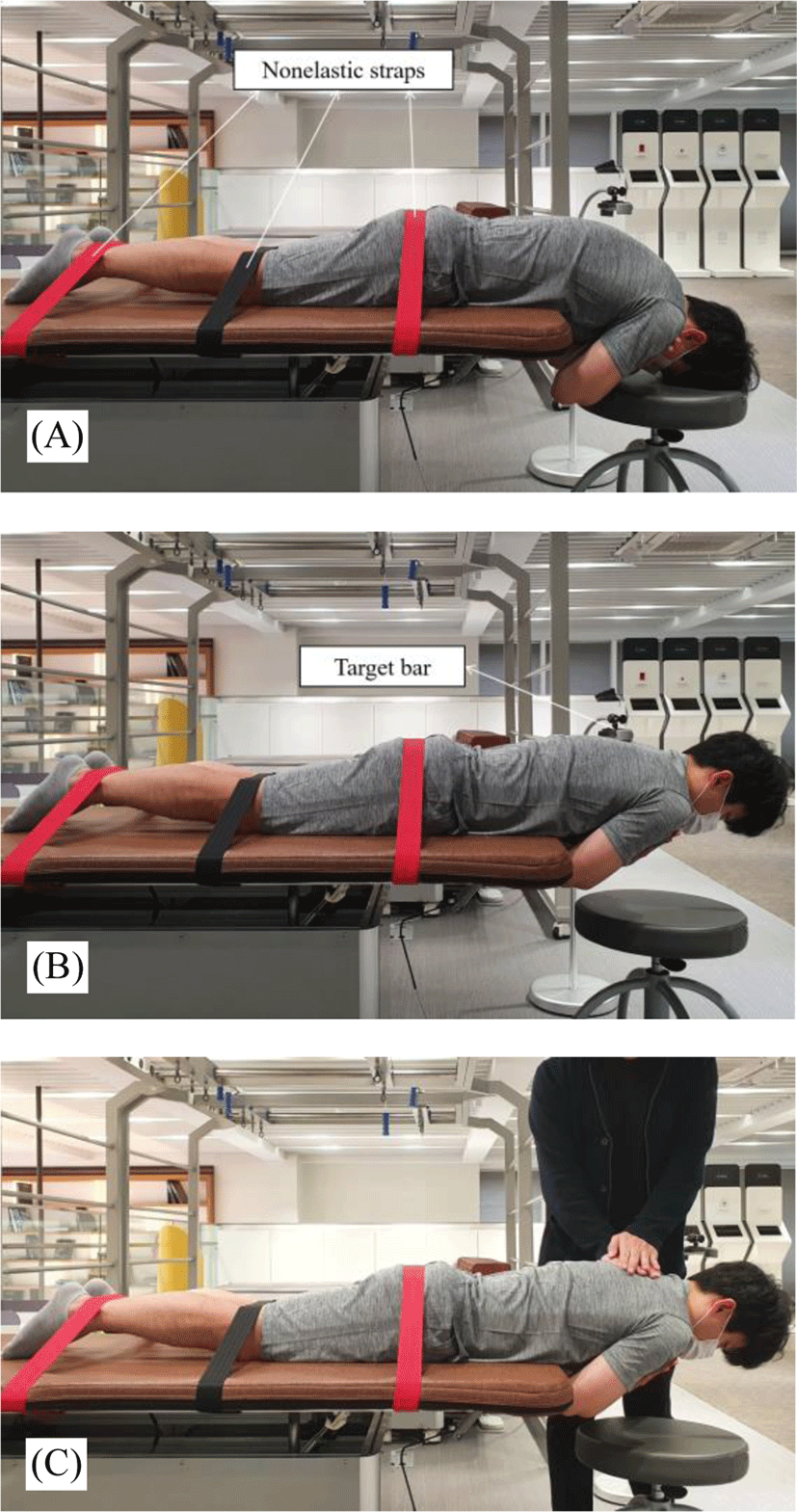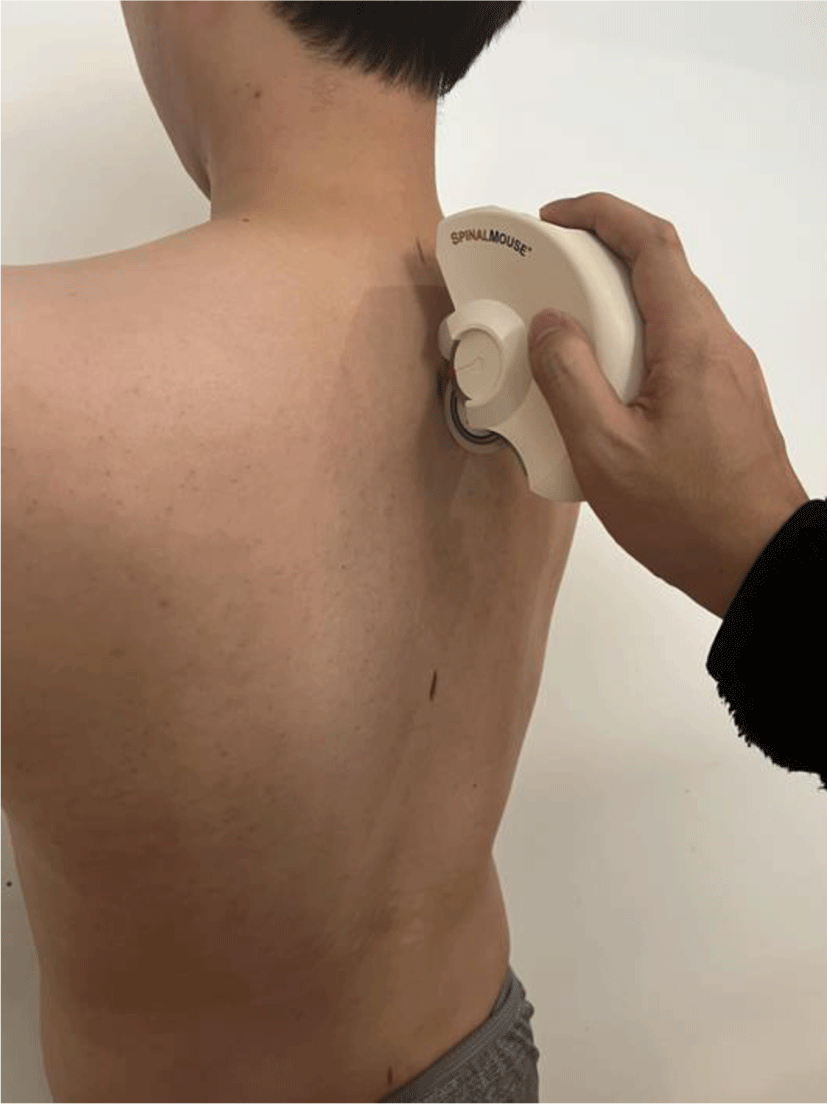INTRODUCTION
Mechanical pain disorders of the thoracic spine are commonly associated with impairment of thoracic spine mobility.1-3 Impairment of thoracic spine mobility is frequently reported in axial rotation and extension.4 Thoracic spine extension mobility (TE) is required in the end range of shoulder flexion,5 and is essential for ideal pattern of trunk extension.
Prone trunk extension is performed to check the ideal trunk extension pattern.6 Park et al. reported that those with a slouched posture had smaller thoracic spine extension and greater lumbar extension during the prone trunk extension compared to those without slouched posture.7 Also, the muscle activity ratio between the thoracis and lumborum of erector spinae was lower in those with a slouched posture.7 During prone trunk extension, the thoracic extensor is decreased and the lumbar extensor is excessively activated, which is a factor inducing low back pain.8-10 Therefore, muscle activity of thoracic erector spinae was emphasized to manage and prevent low back pain.11
During the thoracic extension, the thoracic erector spinae such as longissimus thoracis (LT), and iliocostalis lumborum pars thoracis (ICT) are activated.6,7 However, since the erector spinae muscle of lumborum such as iliocostalis pars lumborum (ICL) can be used as compensation during trunk extension, it is important to confirm the ratio between the thoracis and the lumborum of the erector spinae such as LT:ICL and ICT:ICL.6,7,12 Therefore, the current study compares the muscle activity ratio between the thoracis and the lumborum of the erector spinae according to TE during prone trunk extension. It was hypothesized that the individuals with high TE will have greater muscle activity of thoracis and ratio between the thoracis and the lumborum of the erector spinae compared with low TE.
METHOD
Ninety-four healthy individuals who thought they had hyperkyphosis were recruited through Internet advertisements in Table 1. Individuals with the following characteristics were excluded: scoliosis and a history of spinal column fracture, spinal tumors and related malignancies, congenital spinal anomalies, cancer, or rheumatoid arthritis.13 Participants measured thoracic spine extension mobility (TE) using a spinal mouse (Idiag AG, Fehraltorf, Switzerland) and assigned groups according to mean and standard deviation (mean=24.76, standard deviation=9.69). Participants with TE greater than 1/2 standard deviation from the mean were assigned to the high mobility group (>29.6, n=31), and those with TE less than 1/2 standard deviation from the mean were assigned to the low mobility group (<19.9, n=31). Thirty-two participants who did not meet the group assignment criteria were excluded from the study. The study was approved by the Institutional Review Board of Yonsei University Wonju (1041849-202101-BM-009-01).
The angle of TE was defined as the difference between the angle of thoracic kyphosis in standing and the end range angle during thoracic extension.1 The angle of thoracic kyphosis in standing and the end range angle during thoracic extension was measured using a Spinal Mouse (Idiag AG, Fehraltorf, Switzerland). To measure the angle of thoracic kyphosis, each participant was instructed to stand in a comfortable (habitual) position facing the front with the crossed-arm (Figure 1).14 Then, the participant wrapped both hands behind the head with the upper arms against the ears for the end range angle during thoracic extension.14 The participants were instructed to “point the elbows toward the ceiling and arch backward.” We measured the angle of thoracic kyphosis and end range during thoracic extension twice. For global spinal angles, the device is a reliable and valid device.15-17
The angle of thoracic kyphosis and end range during thoracic extension was measured using a Spinal Mouse system (Idiag, Fehraltdorf, Switzerland).18 The Spinal Mouse has accelerometers that record change of inclination and intersegmental distance of spinous processes. The device contains two rolling wheels follow the spinous processes of the spine, and the data are transferred from the device to a computer (sampling frequency of approximately 150 Hz).19 These data are used to calculate the relative angles between the vertebrae and total angle of sagittal plane using Spinal Mouse software. For global spinal angles, the device is a reliable and valid device.15-17
The muscle activity of the LT, ICL, and ICT was measured using the Noraxon Ultium ESP System (Noraxon USA, Inc., Scottsdale, AZ) according to Criswell.20 Skin impedance was reduced by shaving excess body hair, if necessary, gently abrading the skin with fine grade sandpaper, and wiping the skin with alcohol swabs. Signals were collected using MyoMuscle™ MR3 3.14.52 (Noraxon Inc.). The raw electromyography signals were band-pass filtered (20–450 Hz), and the root mean square values were calculated using a 50-ms window. Data were recorded at a sampling rate of 2,048 Hz. The muscle activity was measured when participants maintained their thoracic extension at the prone position (Figure 2).14 And the muscle activity was expressed in % maximum voluntary isometric contraction.

Statistical analyses were conducted with SPSS ver. 20.0 (SPSS Inc., Chicago, IL, USA). The Kolmogorov-Smirnov test was used to confirm that the data were normally distributed. An independent t-test was used to compare the muscle activity of LT, ICT, ICL, ratio of LT:ICL, and ICT:ICL between the low and high mobility groups. A value of p<0.05 was taken to indicate statistical significance.
RESULT
All variables showed a normal distribution in Kolmogorov- Smirnov test (p>0.05). The result for the independent t-test between the low and high mobility groups is shown in Table 2. The muscle activity of LT, the ratio of LT:ICL, and ICT:ICL significantly increased in the high mobility group (p<0.05).
DISCUSSION
In a previous study, the difference in muscle activity during prone trunk extension was compared by dividing groups according to alignment such as slouched posture.7 However, since the muscle activity is accompanied by mobility, not only alignment but also movement should be considered. Therefore, in this study, the high mobility group and the low mobility group were divided and compared according to TE, and there was a significant difference between the groups in ratio of LT:ICL, ICT:ICL, and muscle activity of LT.
The ratio of LT:ICL and ICT:ICL means the balance of the erector spinae muscle, and the closer the value is to 1, the better the balance of erector spinae between thoracis and lumborum. Park et al. reported that the ratios of individuals without slouched posture were 0.82 and 0.88 (LT:ICL, ICT:ICL sequentially), which is similar to the ratio of the high mobility group in this study (0.73 and 0.80).7 Therefore, as a result of this study, it can be confirmed that the balance of the erector spinae between thoracis and lumborum is reduced in the low mobility group, which can be a factor of low back pain.8-10
Jung et al. reported that muscle activity of LT decreased after improving thoracic extension by applying thoracic mobilization to individuals with hyperkyphosis.14 However, in this study, muscle activity of LT was significantly larger in the high mobility group than the low mobility group. This suggests that not only musculoskeletal factors but motor control factors should be considered in order to improve kinetics including muscle activity as well as kinematics.
Our study has some limitations. First, we enrolled relatively young participants. Thus, our findings cannot be generalized, to participants with old-age. Second, we did not investigate lumbar kinematics during the experiment; future studies should observe lumbar kinematics to confirm the compensatory movement of the lumbar spine during prone trunk extension.
CONCLUSIONS
We found that the muscle activity of LT, and the ratio between the thoracis and the lumborum of the erector spinae is reduced in the low mobility group than the high mobility group during the prone trunk extension. Therefore, we suggest that it should be considered to activate the erector spinae of thoracis and to maintain the balance between the thoracis and lumborum of the erector spinae when treating and managing patients with low thoracic extension mobility.








